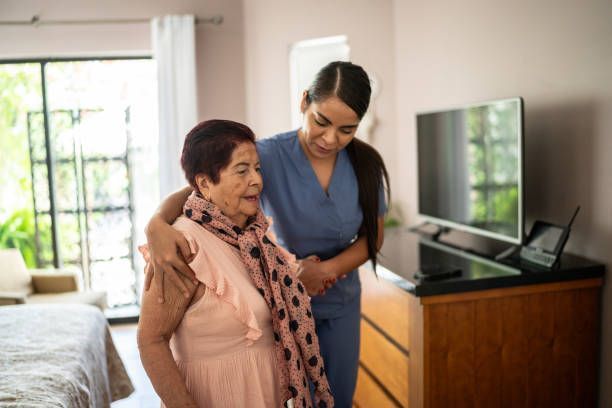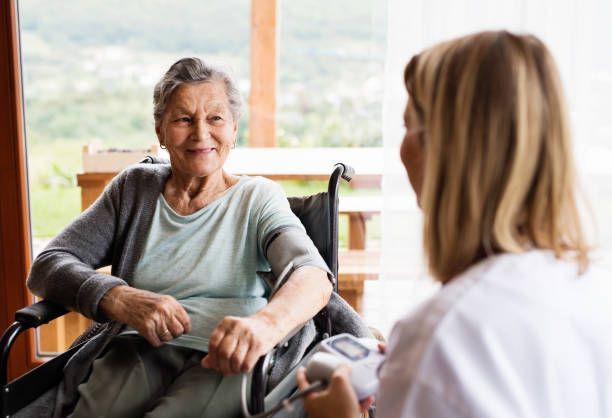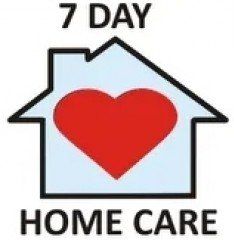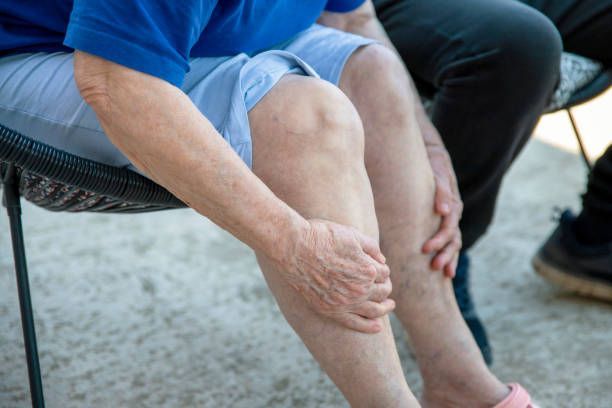Hoyer Lift Guide: How to Safely Transfer Immobile Patients at Home
Hoyer Lift Guide: How to Safely Transfer Immobile Patients at Home
The Hoyer lift, invented in the mid-20th century by mechanical engineer Ted Hoyer, was designed to solve one of the biggest challenges in caregiving: safely transferring individuals with limited mobility without risking injury to patients or caregivers. Today, this innovation remains essential in hospitals, rehabilitation centers, and private homes, where it protects against falls, skin tears, and caregiver back injuries during transfers from bed to wheelchair, toilet, or chair. At 7 Day Home Care, we recognize the importance of this device and have become a leading provider of in-home care services across New York, with outstanding Home Health Aides (HHAs) who are fully trained and experienced in safe Hoyer lift operation. Our HHAs integrate the lift into daily care routines with professionalism and compassion, ensuring that each transfer maintains dignity, comfort, and safety. Under the supervision of Registered Nurses, our care teams not only manage mobility challenges but also deliver comprehensive, individualized support that gives families peace of mind and helps patients remain secure and cared for in the comfort of their own homes.
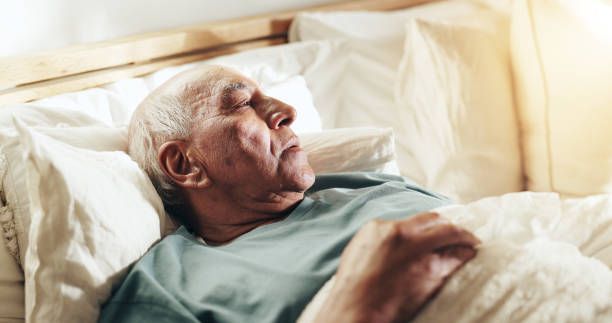
Do You Need Hoyer Lift Trained and Experienced Home Health Aide Care?
Yes, if your loved one requires safe transfers due to immobility, weakness, or fall risk, you need a Home Health Aide trained and experienced in using a Hoyer lift. At 7 Day Home Care, our certified HHAs receive specialized training in proper Hoyer lift techniques, ensuring safe, dignified transfers from bed to wheelchair, toilet, or chair while protecting both patient and caregiver from injury. Our care plans include supervision by Registered Nurses, personalized support tailored to each client’s condition, and coverage in Manhattan, Queens, Brooklyn, Nassau County, and Suffolk County. Families who choose 7 Day Home Care gain peace of mind knowing their loved one is supported by skilled professionals who prioritize safety, comfort, and quality of life at home.
A Hoyer lift is a mechanical patient-transfer device that safely moves people with limited mobility between a bed, wheelchair, toilet, chair, and other surfaces. It lowers the risk of caregiver back injuries and patient falls while preserving dignity. Families typically need one when manual transfers become unsafe because of the patient’s weight, weakness, confusion, or the caregiver’s strain.
What Is a Hoyer Lift and When Do You Need One?
If you’re caring for someone who cannot safely stand or help with transfers, a Hoyer lift may be the safest, most reliable solution. In plain language, a Hoyer lift is a compact, rolling frame with a boom arm and a supportive fabric sling that cradles the patient while a hydraulic pump or electric motor does the lifting. The caregiver positions the base under a bed or around a wheelchair, attaches the sling to the boom, and raises or lowers the person smoothly and in control.
A wide range of conditions can make a Hoyer lift appropriate. People recovering from surgery may need short-term assistance until strength returns. Those living with stroke often have one-sided weakness that makes standing and pivoting unsafe. Progressive neurologic conditions such as ALS and advanced Parkinson’s can limit weight bearing and coordination. Multiple sclerosis and spinal cord injuries often require full support for transfers. Advanced dementia can make it difficult to follow instructions or balance during a manual transfer. Severe obesity can also push beyond what is safe for even two caregivers to lift. In all of these scenarios, a Hoyer lift reduces fall risk, prevents skin tears, and protects caregivers from back injuries.
A Hoyer lift is not a wheelchair or mobility device for moving around the house; it is used only during the transfer itself. It is not a sign of “giving up.” Rather, it is a dignified, practical safety tool that makes daily care sustainable.
Signs It’s Time to Get a Hoyer Lift
Many families wait until there is an accident before adopting a lift. The better approach is to watch for early warning signs. On the patient side, red flags include any falls or near-falls during transfers, visible anxiety or resistance when being moved, bruising or skin tears after attempts to lift, profound weakness that prevents bearing weight, confusion that makes following transfer cues impossible, and frailty that makes even minor bumps risky. On the caregiver side, warning signs include back pain after transfers, dreading bathing or toileting because lifting is hard, needing two people for routine moves, skipping necessary activities to avoid lifting, fear of dropping the patient, and rising tension inside the family over physical care.
Waiting too long raises the risk of fractures and head injuries, pressure ulcers from staying in one position, isolation when moving becomes too difficult, and loss of dignity during rushed, unsafe transfers. For caregivers, delays often lead to back injuries, burnout, medical bills, and strained relationships. Plan ahead if the condition is progressive, at the time of hospital or rehab discharge, when transfers start taking longer or require more effort, or if weight gain or muscle loss is changing what is safe.
How Hoyer Lifts Work: Simple Explanation
The frame is typically steel or aluminum with a wide base on locking casters for stability. The legs can spread to slide around chairs or narrow to pass through doorways. A boom arm overhangs the patient and connects to a sling via hooks or clips. Manual or hydraulic lifts raise the arm with a hand-pumped cylinder and lower with a small release valve. Electric lifts use a battery or wall power with push-button controls; most include a manual backup for emergencies.
A safe transfer follows a predictable sequence. The caregiver positions the lift with the base under the bed or around the chair and explains each step to the patient. A sling is placed under or behind the person using a rolling or seated method, then clipped or looped to the boom arm at symmetrical points. The lift raises the patient just high enough to clear the surface, then the caregiver wheels the lift into position and lowers the person onto the destination surface. Finally, the sling is removed or left in place temporarily, depending on comfort and the next transfer time. With experience, a typical transfer takes five to ten minutes.
Types of Hoyer Lifts and Slings Explained
Families usually choose between manual (hydraulic) and electric lifts. Manual lifts cost less and are extremely reliable because they do not require power, but they demand light pumping effort and tend to move a bit slower. They work well for budget-conscious families, for patients under about 350 pounds, and for one or two transfers per day. Electric lifts cost more but require minimal physical effort and offer consistent, smooth speed at the touch of a button. They are ideal for multiple daily transfers, heavier patients, caregivers with limited strength, and situations where speed reduces patient anxiety. Bariatric models are available in both categories for higher weight capacities.
The sling matters as much as the lift. Full-body slings support the head, trunk, and legs and are the most versatile choice for general transfers and bedridden patients. Toileting slings have an open bottom to allow clothing adjustment and bathroom use while seated, preserving safety and dignity. Mesh or bathing slings are designed for water, drain quickly, and pair well with shower chairs. Positioning slings are thin, comfortable to lie on, and can be left under the patient to assist with frequent turning and pressure relief. Proper sling sizing ensures the patient is centered and supported without sliding or pinching; a sling that is too large allows shifting, while one that is too small creates pressure points.
Step-by-Step: How to Use a Hoyer Lift Safely
Start with a consistent safety checklist. Verify that the patient’s weight is within the lift’s capacity, inspect the frame, sling, and attachments for wear, lock any moving bed wheels, stage the wheelchair or commode with brakes engaged, clear the path, and calmly explain what you’ll do. If you are new to the process, have a second person nearby until you are confident.
Place the sling using one of two common methods. If the patient is in bed and cannot sit, roll them gently onto one side, fold the sling lengthwise, tuck it along the back, roll them over it, then pull the remaining fabric through and smooth wrinkles. If the patient can sit briefly, help them sit at the edge of the bed, slide the sling behind the back, and thread the leg straps under the thighs. Center the head inside the headrest if present and ensure the leg straps are positioned under the thighs rather than behind the knees.
Bring the lift close with the base spread wide for stability, lower the boom arm, and attach the sling’s upper and lower clips symmetrically. Test each connection with a gentle tug. Unlock the casters, then lift slowly while watching the sling and the patient’s expression. Raise only high enough to clear the bed and guide the lift toward the destination. Position the patient over the seat, lower in a controlled manner, and make final adjustments for comfort. Remove the sling if they will remain seated for a while, or leave a thin positioning sling underneath if a return transfer is imminent. After each transfer, confirm brakes are set, the patient is positioned well, and the sling is stored or dried as needed.
Hoyer Lifet Cost, Insurance, and Where to Get One
Families usually decide among purchasing new, buying refurbished, or renting. Manual lifts often range from a few hundred dollars for the base unit to around a thousand dollars with one or two slings included. Electric lifts typically cost more because of the motor and battery and can reach into the low thousands, with bariatric models higher. Extra slings are modestly priced and worth owning in multiples to match bathing, toileting, and general transfer needs. Refurbished lifts from medical equipment suppliers can save a significant percentage off new prices; if buying used, have the unit inspected and purchase new slings for hygiene. Rentals make sense for short-term recovery, for trial before purchase, or when end-of-life timelines are uncertain; weekly and monthly rates vary by region.
Coverage depends on payer. Medicare Part B may cover a lift if it is medically necessary, the physician documents the need after a face-to-face visit, and the equipment comes from an approved supplier; reimbursement usually follows the typical Part B rules. Medicaid coverage varies by state and may be more flexible. Private health insurance can cover purchase or rental with prior authorization. If coverage is denied, appeals succeed frequently when documentation includes diagnosis, functional limitations, failed attempts at manual transfers, and the safety rationale for a mechanical lift. When insurance is not available or sufficient, families sometimes receive assistance from disease-specific foundations, veterans programs, local service organizations, or area agencies on aging.
If you are in the New York region, 7 Day Home Care can recommend reputable suppliers, help collect and submit the necessary documentation, and coordinate nurse training so you are comfortable using the lift from day one.
Common Problems and Solutions
Sliding in the sling usually means the sling is oversized or mispositioned. Recenter the patient before lifting, ensure the leg straps are properly threaded, and choose a smaller or different style if shifting persists. Fear or resistance, especially with dementia, improves when the caregiver explains each step in a steady voice, practices at very low height first, and avoids rushing. If discomfort occurs, smooth wrinkles, verify correct size, and avoid leaving thick slings under the patient for long periods; position-friendly slings are better when frequent turning is needed.
Equipment issues have simple checks. A manual lift that will not hold height may need hydraulic fluid or professional service; unusual sounds mean you should stop and inspect. An electric lift with a weak battery should be kept on a regular charge cycle and may need a replacement battery every few years. If the base will not fit under furniture, narrow the legs fully, raise the bed slightly if safe, or consider a low-profile base. If clips are difficult to attach, confirm the sling is compatible with your model and replace any bent hardware before use.
Transfers that take too long usually speed up naturally within a week or two as you gain confidence. Prepare everything in advance, accept that “safe and steady” is the goal, and ask for help on difficult days.
Professional Support From 7 Day Home Care
7 Day Home Care provides end-to-end support for families using Hoyer lifts throughout New York City, Long Island, and Westchester. Our registered nurses assess the home, recommend the right lift and sling combinations, coordinate physician documentation for insurance, and train both family members and our Home Health Aides to use the equipment safely and confidently. HHAs experienced in lift transfers integrate safe moves with daily care routines, skin checks for pressure injury prevention, bathing and toileting assistance, and medication reminders. Ongoing RN supervision ensures your techniques remain safe, equipment stays in good working order, and the care plan adapts as needs change. We also help navigate Medicare, Medicaid, private insurance, and long-term care insurance, including Genworth, to reduce the out-of-pocket burden.
Frequently Asked Questions
Is using a Hoyer lift giving up on rehabilitation?
No. A lift enables safe participation in therapy and normal routines without fear of falling. Many people use a lift temporarily during recovery and step down to simpler devices as strength returns.
Can one person operate a Hoyer lift at home?
Yes, after proper training. A second person is helpful during the learning period, with very heavy patients, or when behavior or anxiety complicates positioning.
How do I know we’re using the Hoyer lift correctly?
Transfers feel secure, the patient does not slide, the caregiver is not straining, and there are no pressure marks afterward. If you are unsure, ask a nurse or therapist to observe and coach your technique.
Does Medicare cover Hoyer lifts?
Medicare Part B may cover a lift when medically necessary and ordered by a physician from an approved supplier. Pre-authorization and documentation are key.
What if my loved one refuses to use the Hoyer lift?
Introduce it calmly, practice at very low height, keep a consistent routine, and focus on safety and comfort. For dementia, distraction, reassurance, and familiarity help. Ultimately, preventing injury must take priority.
How long does a Hoyer lift last?
With routine maintenance and proper storage, ten years or more is common. Slings wear faster and should be replaced periodically, especially if washed frequently.
A Hoyer lift is more than a piece of equipment; it is a safety system that protects patients and caregivers, reduces falls and injuries, and restores dignity to everyday routines. Families benefit most when they adopt one before a crisis, receive hands-on training, and integrate transfers into a well-structured care plan. If you are planning a discharge from a hospital or rehabilitation facility or noticing early warning signs at home, 7 Day Home Care can assess your needs, coordinate equipment and insurance, and train everyone involved so your loved one can remain safe, comfortable, and engaged at home.
7 Day Home Care is the top private pay in-home care services provider throughout Long Island, NYC, Manhattan, Queens, and Brooklyn, New York. 7 Day Home Care is a licensed home care agency under New York State Department of Health. To learn more about our specialized Home Health Aide services for patients needing Hoyer lift assistance at home, please call 516-408-0034 today.
Brian Callahan
7 Day Home Care

